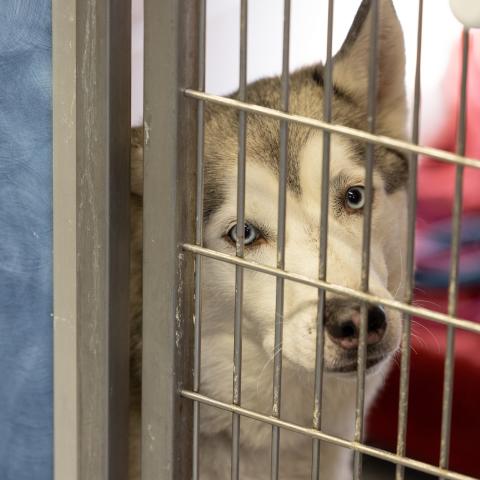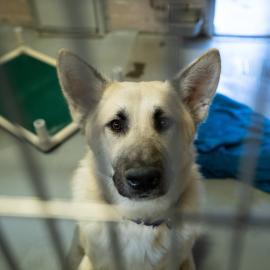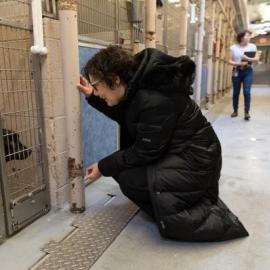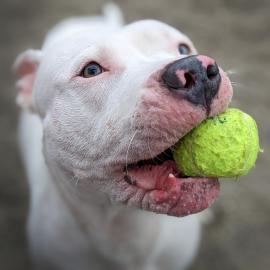MCAS Changes Updates - January to May 2023
Learn about progress MCAS is making for the official review requested by Multnomah County Chair Jessica Vega Pederson.
Contents
Restructure of Animal Care Unit
- Reorganized Supervisory Reporting Structure And Task Orientation
- Task Assignments by Function
- Scheduled / task blocks
- Dog-to-Dog Meets and Playgroups
- Specialized Programs
- Volunteer Program
- Feline Specialist Changed to Pathway and Enrichment Specialist
- Enrichment Board Added for Canine Intake
- Modified Procedures for More Efficient Cleaning and Feeding
- Kitten protocols
- Increased roles for volunteers
- Transfer, Foster, and Volunteer Onboarding
Overarching/ Management / Administration / Facilities
- Centralized Intranet Hub for Policies, Procedures, and Communications
- Radio Communications
- Leadership Meeting structures
- Staffing Study
- Wait-while Check in and Appointment Management System
- Security onsite
- Improved Grounds/Plantings
- Storage Modifications and Changes
Index of Phase 1 Review Recommendations
- Audit Recommendations - Partially complete or incomplete
- Dogs Playing for Life Recommendations (Partial or Incomplete)
Background
When Chair Vega Pederson initiated the review of Multnomah County Animal Services, it was with the commitment that improvements and changes would not wait for completion of the review process. Rather, Animal Services would continue to address issues in operations, making real time improvements. This document has been prepared to capture changes and improvements made since January 1, 2023 through June 1, 2023. MCAS will continue to document changes and update this document, quarterly, or as needed.
Animal Care
Restructure of Animal Care Unit
Reorganized Supervisory Reporting Structure And Task Orientation
Work is now sorted by “front of the house,” meaning admissions functions, adoptions functions, and the animal health team. Staff now report to one animal care supervisor for “back of the house” functions, which include kennel cleaning, feeding and enrichment activities.
Task Assignments by Function
Animal Care has duties based on their “role” or team assignment within the schedule, for example Paw Patrol, enrichment, or pet support.
Scheduled / task blocks
Animal Care’s duties are based on the expectation of a team assignment, versus individual daily assignments. When a specific call or request is made from Animal Care, the call now goes out for the function and not for the individual.
Example: The task of “Pet Support” has a list of duties that are consistent each day. One of those tasks might be assisting with donations gathering and documentation. If support is needed in this task area, the radio call would go out for “Pet Support at the front desk”.
Previously, all tasks were written out on the schedule, and if no one was assigned then the task was not reliably completed. In addition, staff were calling for specific individuals that they knew would respond to the request. The updated procedure provides more accountability for the teams providing support functions.
Dog-to-Dog Meets and Playgroups
We are continuously working to increase the skills of staff to allow for playgroups whenever possible. We plan to grow and expand this program to try to get every dog as close to the playgroup as possible, as well as working toward an established schedule.
Almost all of the back of house Animal Care staff are now able to do dog-to-dog meets.
Specialized Programs
Temp employees have been added to Support Animal Care, specifically administrative support to the Foster Coordinator and the Volunteer Coordinator.
Volunteer Program
We are exploring improved technology solutions to manage the volunteer program.
Animal Services conducted a volunteer appreciation event on May 20, 2023.
Rounds Review Updates
The rounds review process was updated to include clear notes at each meeting that allow for consistency and understanding on next steps. Additionally, implementation of the rounds review functionality in Shelter Buddy has provided a clear understanding of which pets are reviewed each day. Previously, notes were not taken, which caused confusion and misunderstanding on next steps.
Rounds review times were also shifted from the afternoon to the morning, which allows for action items to be completed on the same day. There is now a dedicated leader and note taker, which, in addition to the use of the Shelter Buddy rounds review functionality, ensures notes are entered and information is not lost or forgotten.
Enrichment Updates
Feline Specialist Changed to Pathway and Enrichment Specialist
The Feline Care Specialist position was changed to a Pathway and Enrichment Specialist for all pets. The goal of this change is to allow for faster workflow and decision making regarding enrichment for pets in the shelter and foster pets.
Enrichment Board Added for Canine Intake
A whiteboard has been added in the canine intake area to document enrichment activities.
Modified Procedures for More Efficient Cleaning and Feeding
Animal Care staff schedules were altered to allow more support in the morning for cleaning.
Per recommendations from Dogs Play For Life (DPFL), cleaning now starts with the outside kennel sections, and then the interior sections. Staff now set kennels up with food and enrichment items when they come back to the inside. Previously, animals were fed and then placed outside during cleaning.
This approach has multiple advantages to help alleviate stress:
- Dogs no longer go outside first thing in the morning when it is still dark and cold, and are instead going outside later when it is a little warmer and brighter.
- Dogs are not placed outside with any urine or feces in the outdoor kennel section from the previous night.
- The indoor kennel portion is arranged with enrichment and food when dogs return from the outside.
- Feeding is no longer rushed, and dogs can eat at their own pace.
Kitten protocols
Staff meet twice a week for cat intake protocols for clearer, more uniform, and streamlined work. The intake policy was updated and we met with each unit to ensure understanding of the policy.
Increased roles for volunteers
Roles for volunteers were increased to include the following:
- Staffing of the Information Desk
- Kennel cleaning duties
Transfer, Foster, and Volunteer Onboarding
Procedures were updated to provide clearer communication about the expectations of these programs. While this is still an ongoing process, we are looking at the information we provide during the onboarding of these programs. We aim to set clear expectations up front to be able to hold foster volunteers accountable should they step out of those expectations in the future.
Animal Health
Oregon Humane Added as Veterinary Services Voucher Partner
In response to critical veterinary staff vacancies, MCAS is contracting with veterinary service providers in the community to provide spay/neuter and vaccination services to adopted pets as needed. OHS was added as a provider in early 2023, and their scheduling capacity to efficiently serve recent adopters is significant. MCAS is arranging to perform many needed services pre-adoption via transport to and from the OHS Community Veterinary Hospital. Services will include pre-adoption spay and neuter.
MCAS is prioritizing the surgery schedule to focus on population control, making female cats, dogs and rabbits a priority. We are performing in-house surgery for animals who have rescue or transfer options once altered.
Volunteers and foster parents are being asked to participate in a foster kitten vaccine clinic to help administer treatments to kittens in our care and to relieve the burden on animal health staff.
To provide more veterinary coverage Thursdays-Sundays, we are utilizing and expanding the pool of relief veterinarians.
Field Services
Bite Quarantine updates
Changes to the home quarantine policy to match state requirements - Specifically, home quarantine will no longer be allowed if the bites inflicted were severe in nature, the pet was at large/loose when the bite occurred, the pet had previously been classified as potentially dangerous or is not current on rabies vaccination.
Protective Custody Cases
Procedures have been implemented to make communications to the public clearer. This includes development of a template that is used by field officers to communicate the status of protective custody cases and next steps. This updated procedure will also result in improved due process for pet owners as well as clarity about decision making related to notice of infraction.
Client Services
Opened the Building to In-person Adoptions
In-person adoption services resumed on January 11, 2023. Through the pandemic, all adoptions were screened through an online application process and phone consultations.
ID Trace Procedure Updates
A uniform policy for all staff to follow when utilizing ID trace to identify pets with unknown owners was implemented. ie. number of attempts and number of days.
Phone Tree Updates
MCAS is working with County telecom/IT to activate improved prompts in our call system so that clients may have a better experience and direct calls to the appropriate staff more efficiently.
Overarching/ Management / Administration / Facilities
Centralized Intranet Hub for Policies, Procedures, and Communications
An intranet site for MCAS staff has been created for centralized communications, policies, procedures, and training materials. It is now in the process of set up, training, and implementation.
Radio Communications
MCAS purchased new radios, provided training, and is consistently using the radios. Radios are now used by all management, line staff, and volunteers to manage the flow of work, communication regarding need for assistance, and emergency response.
Leadership Meeting structures
The schedule of leadership meetings was readjusted to bi-weekly, and the structure was updated to focus on overall updates with breakout meetings that occur based on information and need. This provides a better structure that is more about in the moment communication instead of waiting to discuss at a fixed point in time. Previously, all concerns and problems were only brought up at the appointed time at a leadership meeting.
Capacity Calculations
MCAS started the baseline capacity calculations to have a clear understanding of when MCAS was “in trouble” with space. The goal is to further expand this into a set up with clearer calculations (ex: red, yellow, green) that help determine the actions MCAS takes.
Staffing Study
Based on the established shelter capacity, we evaluated average daily population trends from CY 2022, and utilized formulas and recommendations from the National Animal Care & Control Association and regional partners. MCAS conducted a staffing study to meet national recommendations for cleaning and feeding:
Wait-while Check in and Appointment Management System
Waitwhile is a specialized scheduling software that assists MCAS in adoptions support and volunteer and other appointments. The software provides virtual waitlist and queue management. It is now in the process of set up, training, and implementation.
Security onsite
An on-site security guard was added for safety, and to set clear expectations for handling persons of interest.
Improved Grounds/Plantings
Improvements have been made to the physical site, including:
- Pea gravel in the play yard
- Improved groundskeeping
- Fresh paint
- New signage either in place or on order
- Temporary coverings over outdoor dog kennels to protect from inclement weather
- Roll down screens on front of south facing outdoor kennels to protect from heat and sun exposure
- Restriped parking lots
- Purchase of a new forklift
- Purchase of a speaker system that will support auditory enrichment for all pets in care. This will be linked to a computer program that will have a variety of options including music and reading aloud. This is currently pending installation
Storage Modifications and Changes
The following changes have been implemented for storage:
- Meal Prep room improvements, paint, storage supplies, and a new freezer
- Addition of sheds for more efficient storage
Index of Phase 1 Review Recommendations
Audit Recommendations - Partially complete or incomplete
- The new animal database should include mandatory fields that must be completed for every animal.
- The new animal database should produce reports that are accessible online by the public.
- Clearly document what information is disclosed about an animal at the animal's adoption or transfer.
- Evaluate existing operating procedures and ensure that employees know how to access and use them.
- Develop and implement standard operating procedures for areas that lack them.
- Maintain documentation of all training.
- Conduct manual checks to ensure that there is not conflicting information in the animal records.
- Document all behavioral concerns and discuss them with potential owners before adoption.
- Animal Services needs to clarify how it decides an animal is safe. We saw detailed medical histories that provided reasoning for why an animal was euthanized or not. But for animals with behavioral issues, we saw a lack of detailed notes. The reasons for decisions were not easy to determine. Daily behavioral notes for animals and documenting the reasons for decisions would support transparency and consistency.
- Provide ongoing training to employees and volunteers on workplace safety issues, ranging from managing difficult conversations to workplace violence scenarios.
- Provide shelter employees, particularly management employees, with training on County personnel rules, which require that the workplace be respectful, professional, safe, accepting of cultural differences, and free from inappropriate or abusive workplace behavior.
- Establish contingency housing to ensure that the shelter can accept all animals brought to it by County residents and Field Services' Animal Control Officers.
- Remediate the health and safety issues that Risk Management identified in its Safety Site Visit report as soon as possible.
- Implement a formal training program for new staff as well as ongoing training.
- Maintain documentation of all enrichment provided, and track this information to ensure all animals receive enrichment consistently
- Comprehensively study total staffing needs, and advocate to the Board of County Commissioners for increased staffing as necessary to help protect the health of the animals in shelter care, including:
- Institute a daily rounds program that includes, at minimum
- a rounds team involving people from different shelter units
- daily decision-making that is clear and specific
- documentation of rounds' observations, decisions, and actions.
- Planning documents should include, clear and specific project mission that fits into the larger strategic goals, sufficient and appropriate staffing, staff training, realistic and measurable goals, and cost/benefit analysis.
- Ensure that all euthanized animals are recorded in both the drug logs and the animal records database.
- Provide a comprehensive enrichment program to all cats and dogs in every section of the shelter to ensure each animal receives daily social contact, mental stimulation, and physical activity.
Dogs Playing for Life Recommendations (Partial or Incomplete)
- Implement walk boards to track daily enrichment of all dogs, listing eligible dogs by location, recording every outing.
- Photograph the board daily and file electronically for future reference.
- Prioritize time for Animal Care Technicians (ACT) and Animal Care Aides (ACA) to participate in enrichment activities with the animals through schedule changes; Canine Care Specialist (CCS) mentor appropriate staff; management maintain staff focus.
- Reallocate Canine Care Specialise (CCS) job from 25% behavioral assessments, 25% enrichment activity, 25% supervising animal “flow’ through shelter, and 20% data entry and reporting to 80%-95% of their time ensuring enrichment for every dog in the facility, primarily by shifting those other responsibilities to the volunteer and / or admin. staff. Also utilize ACTs, ACAs, and volunteers for enrichment through shadowing with the CCS.
- Create a Canine enrichment coordinator position to work under the new CCS position to emotionally and behaviorally maintain daily playgroups and other out-of-kennel opportunities.
- CCS conduct daily walk through to ensure every eligible dog that can be walked is (and assign this responsibility to another staff member when CCS is off)
- Create a daily task list to ensure every dog has their needs met daily
- Clean the outside, back side of the kennels first (avoid canines living in their elimination area); ensure waste is removed frequently throughout the day
- Move from a standardized Behavioral Assessment to a “check point system”
- Create a policy that prevents all handlers (staff and volunteers) from taking dogs out of the front of the kennels.
- Continue to develop a policy allowing mentor volunteer access to intake kennels to support the Every Dog, Every Day (EDED) model and promote community advocacy and enthusiasm
- Require volunteers and staff to use designated walking/training equipment for each dog
- Consider scheduling blocks during the day for dog handling and engagement to close all guillotines and provide in kennel enrichments, improve safety to handlers by allowing dogs to be handled in less stimulating kennels, reduce stress for dogs by separating from reactive dogs, and facilitating padlocks being off walkway gates at designated times
- Provide training to improve playgroups
- Create laminated alert/caution signs to be hung on kennels (front and back) with date of handling concern and initials of reports, with updates during the CCS daily walk through. Record details of the event in the current monitoring sheets.
- Provide critical safety equipment for handling fractious dogs, such as Kevlar gloves and carabiner clips.
- Track concerning interactions with dogs to capture critical knowledge regarding handling and safety but avoid unnecessary or repetitive monitoring that may be unproductively time consuming.
- Enforce ACO’s providing field handling documentation.
- Implement DPFL’s Every Dog, Every Day! (EDID!) Enrichment programming
- Find creative alternatives to housing dogs for more than 90 days.
- Reframe perspective to enforce that “Every Dog, Every Day!)” is accomplishable and mandatory!
- Separate out larger dogs in statistical reporting to paint a clearer picture of where the shelter can focus their efforts to improve services as larger dogs are recognized as a comparative “population at risk” nationwide.
- Add substantial covering to all play yards
- Consider adding visual barriers to the backsides of the kennels
- Add natural light source to security building for dogs confined in long term housing
- Give special emphasis for enrichment to dogs in the intake building, and all green and orange dogs who currently have no eligible volunteer to handle
- Create incentives for staff/volunteers to do daily sessions of “click for quiet” to teach and promote calm kennel behavior, reduce barrier reactivity to people, and create a positive association with strangers
- Implement “Give a Dog a Bone” program for dogs in security to provide enrichment without contact
- Consider initiating a “reading to dogs” Program with children in the afternoon to help promote calm and quiet behavior in the fronts of the kennels while dogs are safely being taken out of the backs for walks and play time
- Create “hand off” protocol and signage for more challenging dogs (handler to handler)
- Maintain consistent enrichment records; consider only recording significant incidents (both positive and concerning) to more easily identify progression and/or regression. Assume all animals are doing well unless otherwise stated.
- Clearly identify which behaviors need to be strengthened to help stabilize a dog emotionally and/or to make them more appealing to adopters
- Clearly identify which behaviors need to decrease and/or be extinguished for safety
- Redirect self-rewarded behaviors that need to be decreased
- Use Gentle Leaders; introduce during play sessions if the dog is not used to them; create signage indicating dogs learning to wear them.
- Consider using “clicker training” or similar for fractious dogs; ensure they receive enrichment.
- Refrain from relying on relationships to progress behaviors (save that for when they go home).

Motoya Nakamura


